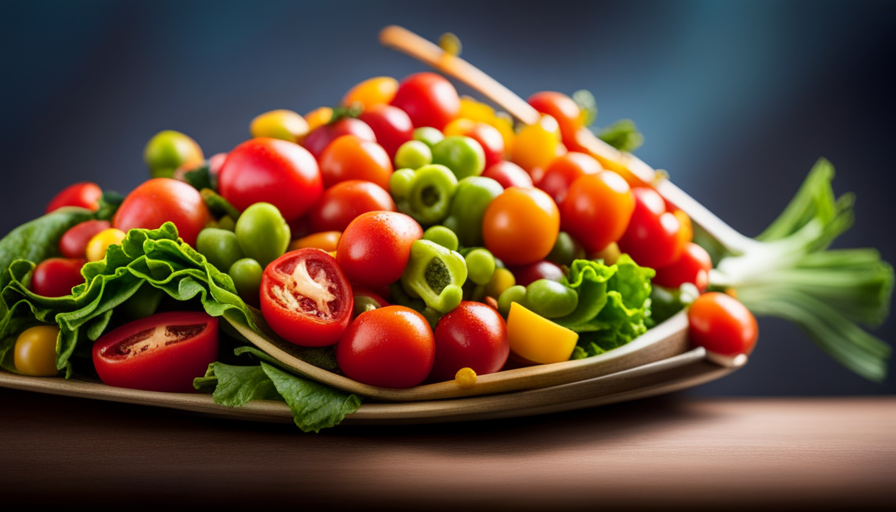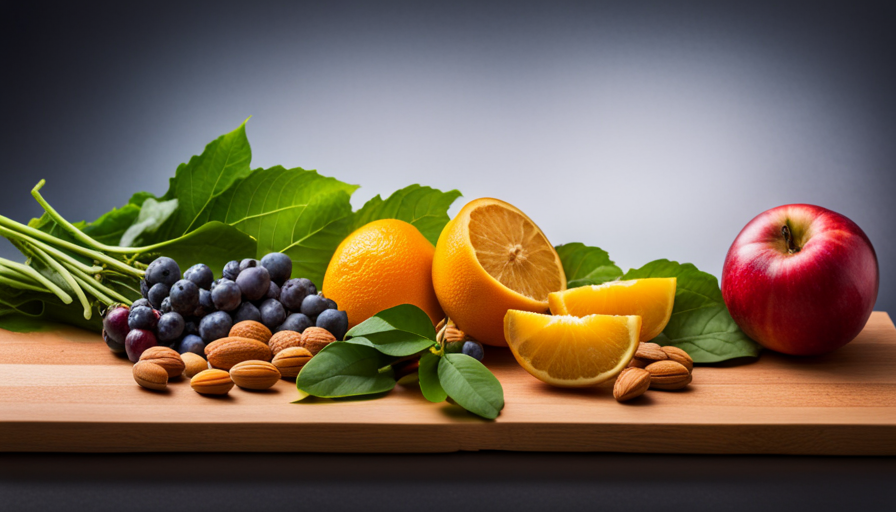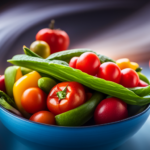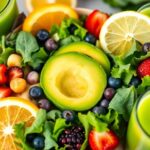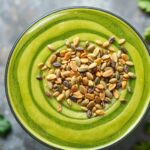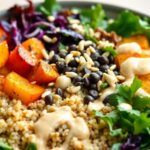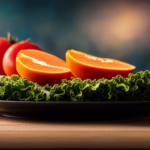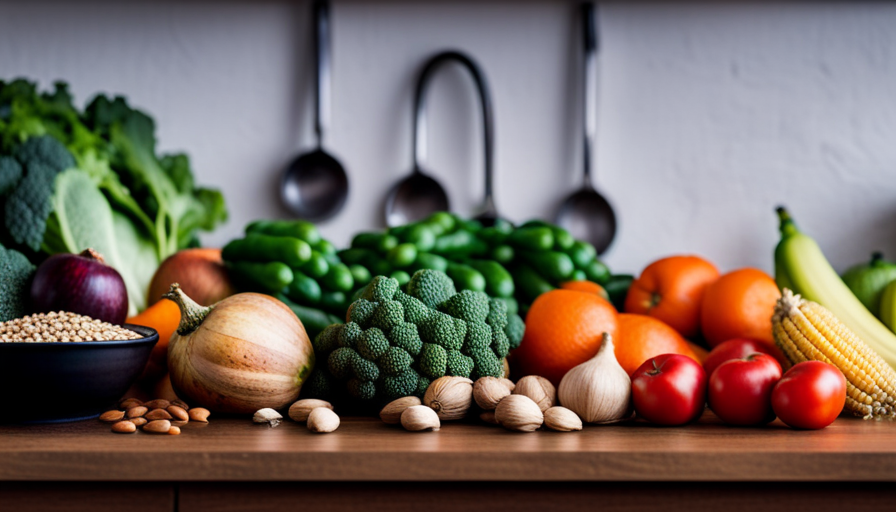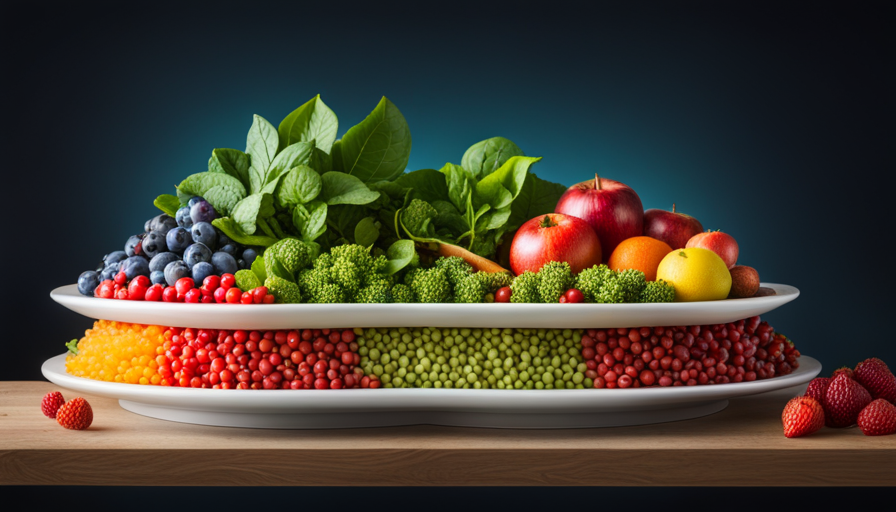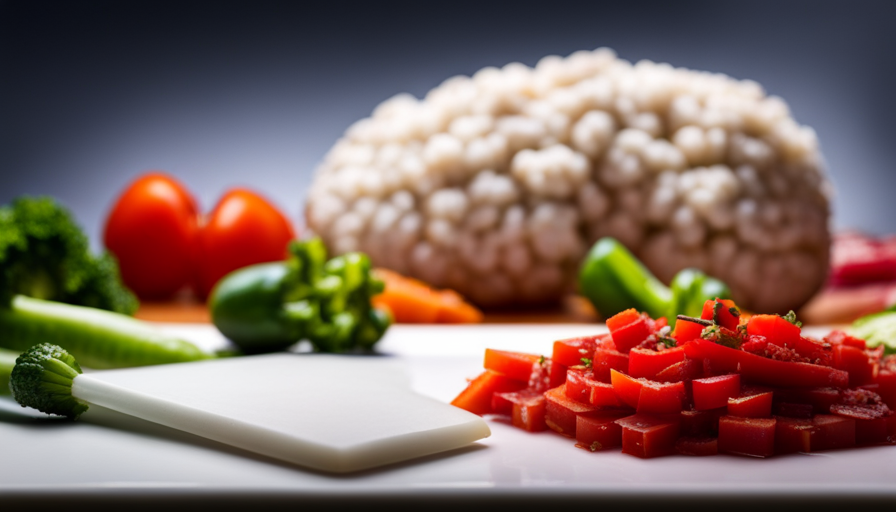Imagine biting into a crisp, juicy apple and savoring the blend of sweet and tangy flavors that excite your taste buds. Alternatively, picture a bowl overflowing with vibrant, crunchy vegetables, each bite delivering vital nutrients and vitality.
These are just a few examples of the wonders of raw food – a culinary approach that celebrates the natural state of ingredients and their immense nutritional value. As a nutritionist, I am excited to delve into the world of raw food and explore what truly constitutes this nourishing way of eating.
In this article, we will define raw food and discuss its various categories, including fruits, vegetables, nuts, grains, dairy, and more. We will also explore the preparation techniques and provide tips for transitioning to a raw food diet.
So, let’s embark on this enlightening journey together and discover the incredible benefits that raw food can offer for our health and well-being.
Key Takeaways
- Raw food refers to food that is not cooked or heated above a certain temperature.
- Raw food enthusiasts follow a diet consisting of fruits, vegetables, nuts, seeds, and sprouted grains.
- Consuming raw food ensures maximum nutritional benefit and can boost the immune system and reduce the risk of chronic diseases.
- Transitioning to a raw food diet can be a gradual process, starting with small changes and seeking guidance from a raw food community or nutritionist.
Definition of Raw Food
So, you’re probably wondering, what exactly is raw food? Well, let me break it down for you.
Raw food refers to any food that isn’t cooked or heated above a certain temperature, typically around 104 to 118 degrees Fahrenheit (40 to 48 degrees Celsius). This means that raw food enthusiasts follow a raw food diet, which primarily consists of fruits, vegetables, nuts, seeds, and sprouted grains.
Raw food recipes are carefully crafted to preserve the natural enzymes, vitamins, and minerals present in these foods. The idea behind this diet is that cooking can destroy or reduce the nutritional content of food, and consuming raw food ensures that you get the maximum nutritional benefit.
A raw food diet is known for its numerous health benefits. Raw fruits and vegetables, for example, are packed with fiber, antioxidants, and phytochemicals, which can boost your immune system, improve digestion, and reduce the risk of chronic diseases. Additionally, raw food can aid in weight loss, increase energy levels, and promote a healthy complexion.
However, it’s important to note that there are potential drawbacks to consuming raw food. Some people may find it challenging to meet their nutritional needs solely through a raw food diet, as certain nutrients like vitamin B12 and iron are more easily obtained from cooked foods. It’s also crucial to ensure food safety and proper hygiene when working with raw ingredients.
Now, let’s delve into the specifics of raw fruits and vegetables.
Raw Fruits and Vegetables
Eating raw fruits and vegetables offers numerous benefits for our overall health. They’re rich in vitamins, minerals, and antioxidants that support our immune system and help prevent chronic diseases.
Incorporating raw fruits and vegetables into our diet can be as simple as adding them to salads, smoothies, or enjoying them as snacks. By doing so, we can boost our nutrient intake and improve our overall well-being.
Benefits of Eating Raw Fruits and Vegetables
Indulging in the succulent sweetness of raw fruits and vegetables is like savoring nature’s vibrant and invigorating gift. Raw fruits and vegetables offer numerous health benefits and are packed with essential nutrients. They’re rich in vitamins, minerals, fiber, and antioxidants that support overall health and well-being.
Eating raw fruits and vegetables can help boost the immune system, improve digestion, and promote healthy skin. Additionally, their low calorie and high water content make them an excellent choice for weight management. However, it’s important to note that some nutrients, such as certain vitamins and antioxidants, may be reduced during cooking.
Therefore, incorporating a variety of raw fruits and vegetables into your diet can help ensure you receive the maximum nutritional value. Transitioning into the subsequent section about how to incorporate raw fruits and vegetables into your diet, it’s important to explore different recipes and creative ways to enjoy these nutritious foods.
How to Incorporate Raw Fruits and Vegetables into Your Diet
To fully experience the vibrant benefits of raw fruits and vegetables, you can effortlessly incorporate them into your daily meals and snacks. One way to do this is by getting creative with raw food recipes. Try making a refreshing fruit salad with a variety of colorful fruits or a crunchy vegetable stir-fry using raw veggies like bell peppers, carrots, and broccoli.
You can also blend raw fruits and vegetables into smoothies for a quick and nutritious snack. Another tip is to include raw fruits and vegetables in your meal planning. Stock up on a variety of produce and include them in your weekly menu. This will ensure that you always have raw options available.
By incorporating raw fruits and vegetables into your diet, you can enjoy their numerous health benefits while adding delicious and nutritious options to your meals.
Now, let’s explore the benefits of consuming raw nuts and seeds.
Raw Nuts and Seeds
Raw nuts and seeds offer numerous nutritional benefits that can enhance our overall health and well-being. They’re packed with essential vitamins, minerals, and healthy fats that support brain function, heart health, and immune system function. Additionally, learning how to properly soak and sprout nuts and seeds can increase their digestibility and unlock even more nutrients, making them an excellent addition to a balanced and nutritious diet.
Nutritional Benefits of Raw Nuts and Seeds
Eating raw nuts and seeds can provide a significant boost to your overall health, as they are packed with essential nutrients and contribute to a lower risk of heart disease. Raw nuts and seeds are rich in healthy fats, protein, fiber, vitamins, and minerals. They are also a great source of antioxidants, which help protect the body against oxidative stress and inflammation.
Below is a table comparing the nutritional profiles of different raw nuts and seeds:
| Nut/Seed | Protein (g) | Healthy Fats (g) | Fiber (g) | Vitamins | Minerals |
|---|---|---|---|---|---|
| Almonds | 6 | 14 | 3.5 | Vitamin E, B2, B3 | Magnesium, Phosphorus |
| Walnuts | 4 | 18 | 2 | Vitamin E, B6 | Copper, Manganese |
| Flaxseeds | 5 | 12 | 8 | Vitamin B1, B6 | Manganese, Magnesium |
| Chia Seeds | 4 | 9 | 11 | Vitamin B3 | Calcium, Phosphorus |
Including raw nuts and seeds in your diet can provide a wide range of health benefits. They can help lower cholesterol levels, regulate blood sugar, improve digestion, and support weight management. They are also a convenient and portable snack option. In the next section, we will explore how to soak and sprout nuts and seeds to enhance their nutrient availability and digestibility.
How to Soak and Sprout Nuts and Seeds
Get ready to learn how to soak and sprout nuts and seeds to take their nutritional benefits to the next level!
Soaking techniques and sprouting methods are simple yet effective ways to enhance the digestibility and nutrient availability of nuts and seeds. Here are four reasons why soaking and sprouting are beneficial:
-
Increased nutrient absorption: Soaking and sprouting activate enzymes that break down anti-nutrients, making the nutrients more accessible to our bodies.
-
Improved digestion: Soaking helps remove enzyme inhibitors and phytic acid, which can hinder digestion and nutrient absorption.
-
Enhanced nutrient profile: Soaking and sprouting increase the levels of vitamins, minerals, and antioxidants in nuts and seeds.
-
Reduced allergenicity: Soaking and sprouting can help reduce the allergenic potential of nuts and seeds.
By incorporating soaking and sprouting into our diet, we can maximize the nutritional benefits of nuts and seeds.
Now, let’s dive into the next section on raw grains and legumes.
Raw Grains and Legumes
When it comes to the benefits of eating raw grains and legumes, there are several key points to consider.
First, raw grains and legumes are rich in nutrients such as fiber, vitamins, and minerals, which can support overall health and digestion.
Additionally, consuming raw grains and legumes can help to preserve their natural enzymes and antioxidants, which can provide additional health benefits.
As for how to prepare raw grains and legumes, soaking them overnight and sprouting them can help to remove anti-nutrients and improve their digestibility.
Cooking at low temperatures or using methods like fermentation can also be beneficial in enhancing the nutritional value of raw grains and legumes.
Benefits of Eating Raw Grains and Legumes
One major advantage of consuming raw grains and legumes is the potential boost to your overall health. Raw grains and legumes are packed with essential nutrients, enzymes, and antioxidants that can support a strong immune system, improve digestion, and promote healthy weight management.
Here are three key benefits of including raw grains and legumes in your diet:
-
Increased nutrient availability: Sprouting legumes increases their nutrient content and makes them more easily digestible, allowing for better absorption of vitamins, minerals, and proteins.
-
Improved gut health: Raw grains and legumes contain natural fibers that promote a healthy gut microbiome, aiding in digestion and reducing the risk of gastrointestinal disorders.
-
Versatile recipe options: Raw grains can be used in a variety of recipes, such as salads, smoothies, and energy bars, providing a delicious and nutritious addition to your meals.
Transitioning to the next section, learning how to prepare raw grains and legumes can further enhance their nutritional benefits.
How to Prepare Raw Grains and Legumes
Discover the simple yet effective ways to unleash the nutritional power of grains and legumes through proper preparation techniques. When it comes to raw grains, soaking and sprouting are key steps in unlocking their full potential.
Soaking grains in water for a period of time helps to break down anti-nutrients and increase digestibility. Sprouting takes it a step further by activating enzymes, increasing nutrient availability, and reducing cooking time.
As for legumes, cooking is essential to make them safe and easier to digest. Raw legumes contain anti-nutrients that can hinder nutrient absorption and cause digestive discomfort. Cooking not only removes these anti-nutrients but also improves the legumes’ nutritional value by making their nutrients more bioavailable.
By properly preparing raw grains and legumes, you can maximize their nutritional benefits and promote better overall health.
Now, let’s move on to the next section about raw dairy and eggs.
Raw Dairy and Eggs
If you’re craving a creamy and silky experience, dive into the world of raw dairy and eggs, where you’ll be transported to a velvety wonderland of flavors and textures.
Raw dairy alternatives, such as raw milk, cheese, and butter, offer a unique taste profile that can’t be replicated by their pasteurized counterparts. Raw dairy is rich in essential nutrients like calcium, protein, and healthy fats. It also contains beneficial enzymes and probiotics that aid in digestion and promote gut health. However, it’s crucial to source raw dairy from reputable and trusted sources to minimize the risk of contamination.
Raw eggs, on the other hand, aren’t only a versatile ingredient but also packed with essential nutrients. They’re an excellent source of high-quality protein, vitamins, and minerals. Raw eggs provide choline, which is essential for brain health and development. Additionally, they contain biotin, which supports healthy hair and nails. It’s important to note that consuming raw eggs carries a small risk of salmonella contamination. To reduce this risk, it’s recommended to use pasteurized eggs or opt for eggs from organic, free-range hens.
As we transition into the next section about raw meat and fish, it’s important to consider the safety precautions necessary when consuming these raw animal products.
Raw Meat and Fish
Raw meat and fish can provide several benefits when consumed raw. They’re high in protein, essential amino acids, and omega-3 fatty acids, which are important for maintaining muscle mass, supporting brain function, and reducing inflammation in the body.
However, it’s crucial to take safety precautions when consuming raw meat and fish to minimize the risk of foodborne illnesses. These precautions include sourcing high-quality, fresh products, storing them properly, and following proper hygiene practices during preparation and handling.
Benefits of Eating Raw Meat and Fish
Consuming raw meat and fish can provide numerous health benefits when incorporated into a balanced diet. Raw meat and fish are rich in essential nutrients such as protein, omega-3 fatty acids, and vitamins. The enzymes present in raw meat and fish aid in the digestion process, making it easier for our bodies to absorb these nutrients.
Additionally, raw meat and fish retain more of their natural flavors and textures, enhancing the overall dining experience. However, it’s important to note that consuming raw meat and fish carries certain risks, such as the potential for foodborne illnesses like salmonella or E. coli.
To ensure safety, it’s crucial to follow proper handling and storage techniques, as well as sourcing high-quality, fresh products.
Transitioning into the next section, let’s discuss the necessary safety precautions for consuming raw meat and fish.
Safety Precautions for Consuming Raw Meat and Fish
When incorporating raw meat and fish into your diet, it’s crucial to take necessary safety precautions to minimize the risk of foodborne illnesses. Raw meat and fish can contain harmful bacteria such as Salmonella, E. coli, and Listeria, which can cause serious health issues.
To ensure safety, it’s important to handle raw meat and fish properly. This includes storing them at the right temperature, separate from other foods, and avoiding cross-contamination by using separate cutting boards and utensils. Additionally, cooking raw meat and fish to the recommended internal temperature can help kill any potential pathogens.
It’s also advisable to source raw meat and fish from reputable suppliers to reduce the risk of contamination. By following these safety measures, you can enjoy the nutritional benefits of raw meat and fish while minimizing the health risks.
Transitioning to the subsequent section about raw sweeteners and oils, it’s important to understand the various options available for incorporating these into a raw food diet.
Raw Sweeteners and Oils
To fully embrace a raw food lifestyle, you should explore the diverse range of sweeteners and oils available to you. Raw sweeteners, such as honey and maple syrup, aren’t processed or heated, preserving their natural nutrients and enzymes. They provide a healthier alternative to refined sugars and can add a touch of sweetness to your raw desserts and smoothies.
Raw oils, like coconut oil and olive oil, are cold-pressed and unrefined, maintaining their nutritional integrity. They’re rich in healthy fats and antioxidants, promoting heart health and reducing inflammation.
Here are five raw sweeteners and oils that you can incorporate into your raw food diet:
-
Raw honey: This natural sweetener is packed with vitamins, minerals, and enzymes that can boost your immune system and support digestive health.
-
Coconut oil: Known for its medium-chain triglycerides, coconut oil is a great source of energy and can enhance brain function.
-
Maple syrup: Made from the sap of maple trees, this sweetener contains antioxidants and minerals like manganese and zinc.
-
Extra virgin olive oil: This raw oil is high in monounsaturated fats, which can lower cholesterol levels and reduce the risk of heart disease.
-
Raw cacao butter: Derived from cocoa beans, cacao butter is a raw oil that adds a rich and creamy texture to raw desserts while providing essential fatty acids.
By incorporating these raw sweeteners and oils into your diet, you can enhance the flavor and nutritional value of your raw food recipes. Transitioning into the subsequent section about "raw superfoods and supplements," it’s important to continue exploring the wide variety of options available to you.
Raw Superfoods and Supplements
Exploring the wide variety of raw superfoods and supplements can greatly enhance your overall health and well-being. For example, incorporating spirulina into your daily smoothies can provide a powerful boost of antioxidants and essential nutrients, helping to strengthen your immune system and increase energy levels.
Raw superfoods, such as goji berries, chia seeds, and maca powder, are packed with vitamins, minerals, and phytonutrients that support optimal health. Adding these nutrient-dense foods to your diet can help improve digestion, promote healthy weight management, and reduce the risk of chronic diseases.
Raw superfood recipes offer creative ways to incorporate these nutritional powerhouses into your meals. You can enjoy a refreshing kale salad with a sprinkle of hemp seeds or prepare a delicious raw chocolate avocado mousse for a guilt-free dessert. The possibilities are endless!
The impact of raw superfoods on health goes beyond their nutritional content. Many of these foods have been traditionally used in ancient healing practices, and recent scientific research is providing evidence to support their health benefits. For example, turmeric has been shown to have potent anti-inflammatory properties, while acai berries are rich in antioxidants that can help protect against oxidative stress.
Incorporating raw superfoods into your diet requires careful consideration of your individual needs and preferences. While these foods offer numerous health benefits, it’s important to remember that they should be part of a balanced diet and not the sole focus. It’s always a good idea to consult with a healthcare professional or nutritionist to ensure you’re getting the right nutrients for your body.
Transition: Now that we understand the impact of raw superfoods on health, let’s explore some raw food preparation techniques that can help us maximize their benefits.
Raw Food Preparation Techniques
Let’s dive into the world of raw food preparation techniques and unlock the secrets to creating vibrant, nutrient-rich meals that nourish our bodies from the inside out. Raw food preparation techniques involve using methods that preserve the natural integrity of ingredients, ensuring that vital nutrients remain intact. By avoiding high heat and cooking methods that can degrade these nutrients, raw food enthusiasts aim to maximize the nutritional value of their meals.
When it comes to raw food recipes, there are countless options to explore. From colorful salads bursting with fresh vegetables to flavorful smoothies made with raw fruits and vegetables, the possibilities are endless. Raw food preparation techniques also include methods like soaking, sprouting, and fermenting, which enhance the digestibility and nutrient availability of certain foods.
It’s important to note that while raw food can offer numerous health benefits, it may not be suitable for everyone. Some people may find it challenging to meet their nutritional needs solely through raw food, especially if they have specific dietary requirements or health conditions. It’s always advisable to consult with a healthcare professional or registered dietitian before making any drastic changes to your diet.
Now that we’ve explored raw food preparation techniques, let’s move on to the next section where we’ll discuss tips for transitioning to a raw food diet.
Tips for Transitioning to a Raw Food Diet
Transitioning to a raw food diet can be a gradual process, allowing individuals to gradually incorporate more raw fruits and vegetables into their meals while still enjoying cooked foods. For example, Sarah, a busy working professional, started by adding a raw vegetable salad to her lunch every day and gradually increased the amount of raw foods she consumed over time. This approach made the transition easier and more sustainable for her.
Here are some tips for transitioning to a raw food diet:
-
Start with small changes: Begin by incorporating one raw meal or snack into your daily routine. This could be a refreshing fruit smoothie for breakfast or a fresh salad for lunch.
-
Experiment with recipes: Explore different raw food recipes to find ones that you enjoy. There are plenty of delicious options available, from zucchini noodles with homemade pesto to raw vegan desserts.
-
Gradually increase raw food intake: Slowly increase the amount of raw foods you consume each day. This allows your body to adjust and helps prevent any digestive discomfort that may arise from sudden dietary changes.
-
Seek support and guidance: Joining a raw food community or seeking guidance from a nutritionist or dietitian can provide valuable support and advice during your transition. They can help ensure you’re meeting your nutritional needs and offer tips on meal planning and preparation.
Transitioning to a raw food diet takes time and patience. By incorporating these tips into your journey, you can make the transition smoother and more enjoyable, while reaping the benefits of a diet rich in raw, nutrient-dense foods.
Frequently Asked Questions
Can I consume cooked fruits and vegetables on a raw food diet?
Yes, you can include cooked fruits and vegetables in a raw food diet. While the term ‘raw food’ typically refers to uncooked or minimally processed foods, some individuals choose to incorporate cooked foods into their raw food diet.
Cooking can enhance the flavors and textures of fruits and vegetables, making them more enjoyable to eat. However, it’s important to note that cooking can reduce the nutrient content of certain foods, so it’s advisable to include a variety of both raw and cooked options to ensure a well-rounded diet.
Are there any specific types of nuts and seeds that should be avoided in a raw food diet?
When it comes to a raw food diet, it’s important to be mindful of the types of nuts and seeds you include. Some varieties may not be suitable due to potential health risks.
However, many nuts and seeds offer valuable nutritional benefits, such as providing essential fats, proteins, and vitamins. It’s crucial to choose ones that are safe and beneficial for your raw food diet.
Can I consume sprouted grains and legumes on a raw food diet?
Yes, you can consume sprouted grains and legumes on a raw food diet. There are several benefits to incorporating them into your meals. Sprouted grains and legumes are easier to digest, contain more nutrients, and can help with weight management. However, it’s important to note that some sprouted grains and legumes may still contain enzyme inhibitors, so it’s recommended to soak or lightly cook them to neutralize these inhibitors. Remember to listen to your body and consult a professional to ensure a balanced raw food diet.
What are the recommended alternatives for dairy and eggs in a raw food diet?
In a raw food diet, there are several recommended alternatives for dairy and eggs. Plant-based options like almond milk, coconut milk, and cashew cheese can be used as substitutes for dairy products.
For eggs, chia seeds and flaxseeds can be mixed with water to create a gel-like consistency that can replace eggs in recipes.
These alternatives not only provide nutritional benefits but also allow for exploring different sources of protein in a raw food diet.
Can I consume fermented or cured meat and fish on a raw food diet?
On a raw food diet, consuming fermented or cured meat and fish is not recommended. While these foods may be flavorful and have a longer shelf life, they can pose risks to health.
Fermentation and curing processes involve the use of salt, which can lead to increased sodium intake. Additionally, these methods don’t eliminate the potential presence of harmful bacteria.
It’s best to focus on fresh fruits, vegetables, nuts, and seeds for optimal nutrition on a raw food diet.
How Does Processing Raw Food Change its Nutritional Content?
Processing raw food with a food processor for raw desserts can affect its nutritional content. Chopping, blending, or pureeing raw ingredients can lead to loss of nutrients like vitamins, enzymes, and minerals. Additionally, heating during processing can further reduce the nutritional value of the food.
Conclusion
In conclusion, raw food is a nutrient-rich and health-promoting dietary choice. By consuming raw fruits, vegetables, nuts, seeds, grains, legumes, dairy, eggs, sweeteners, oils, superfoods, and supplements, individuals can unlock the full potential of these natural ingredients.
Transitioning to a raw food diet may require some adjustments, but with the right preparation techniques and a willingness to explore new flavors and textures, it can be a transformative experience. Just as a seed grows into a flourishing plant, embracing raw food can cultivate a vibrant and thriving body.

